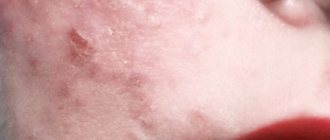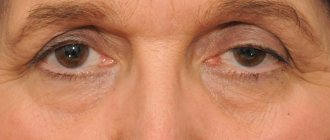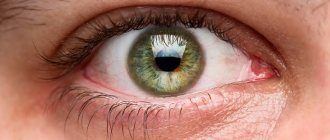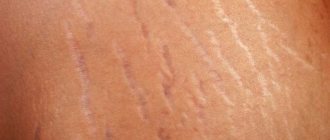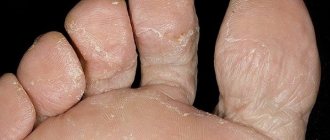The disease is treated by: Pediatric ophthalmologist
- Causes of blepharitis
- Types of blepharitis
- Blepharitis in children: symptoms, diagnosis and treatment
- Diagnostics
- Treatment of blepharitis
Blepharitis is a disease that occurs quite often in children. It is an inflammation of the edges of the eyelids, which is associated with very thin skin and fiber in this place, because the tissue is loose and there is no fat.
As the disease progresses, the eyes do not always change in appearance. This misleads parents, provokes inaction or, in some cases even worse, the use of folk remedies without consulting a doctor. You should know and always remember that blepharitis is a dangerous disease that can have a number of complications.
Causes of blepharitis:
- Staphylococcus aureus;
- the presence of parasites in the body;
- hypothermia;
- infectious diseases;
- psycho-physical fatigue;
- weak immunity;
- problems with the gastrointestinal tract;
- Demodex is a mite that gets into the eyelash bulbs through contact with feathers, birds, diabetes, allergic diseases, etc.;
- helminths;
- constant eye strain;
- getting dirt, dust, smoke, etc. into the eyes;
- diabetes;
- avitaminosis;
- impaired metabolism;
- chronic tonsillitis;
- anemia.
Dry eye syndrome is our silent and dangerous enemy
“The eyes are burning, dry... as if something is constantly interfering... the eyes are watery on the street” - all these are common complaints of people with dry eye syndrome; read about this deceptively simple disease and its consequences below.
Thanks to vision, we receive up to 80% of information about the world around us, while the eye is a complex and fragile structure that is in direct contact with the external environment, and protecting the eyes from injury and infection is an important task for humans. The first protective barrier of the eye is the tear. If the composition or structure of this subtle substance is disturbed, “dry eye” syndrome, one of the most common eye diseases of modern civilization, can develop.
Some important facts about tears
1. Tear is produced by the lacrimal glands: the main lacrimal gland, which works only when crying, and the accessory glands, which produce tears constantly to continuously moisturize and protect the ocular surface.
2. A tear performs several important functions: it moisturizes the ocular surface and protects it from the harmful effects of microorganisms, as well as from dust and other foreign bodies; in addition, the tear nourishes the ocular surface and refracts light
3. The tear film is not just water, it has a complex composition (salts, proteins, fats, enzymes, etc.) and a structure that includes 3 layers:
• lipid outer layer, which prevents excess evaporation and protects against infections;
• aqueous middle layer, which moisturizes, washes away foreign bodies, protects against infections, and refracts light;
• the mucin inner layer, which holds tears on the ocular surface and is involved in the transport of nutrients and oxygen to the cornea.
4. If the composition of the tear changes, one or more of its layers are damaged, then “dry eye” syndrome is formed.
Dry eye syndrome (DES), why does it occur and how does it manifest?
Dry eye syndrome is a complex of signs of desiccation of the ocular surface that develops as a result of long-term disruption of tear stability.
The causes (risk factors) contribute to the development of dry eye syndrome:
A. External:
• Computer or office syndrome (rare blinking, air conditioning, including in cars and airplanes).
• Wearing contact lenses.
• Eye and eyelid injuries, refractive surgery, inflammatory diseases of the cornea.
• Taking medications (oral contraceptives, B-blocks, antidepressants).
• Use of eye drops with preservatives.
B. Internal:
• Age (menopause).
• Chronic eye diseases (glaucoma, blepharitis, allergic conjunctivitis).
• Systemic diseases (Sjogren's syndrome, rheumatoid arthritis, diabetes, thyroid diseases).
Complaints with FHH depend on the stage of the disease and can be very diverse:
• “The eyes are burning, drying, cutting, as if something in the eye is constantly bothering you, tears are flowing on the street, you want to close your eyes or rub your eyes” - these are typical descriptions of the first signs of dry eye syndrome.
• In addition, you may be concerned about: increased sensitivity to cold, heat, pain when instilling any drops, intolerance to air-conditioned air, wind, blurred vision in the evening, fluctuations in visual acuity during the day, photophobia.
Is it dangerous? And how to treat?
If you have one or more of the above symptoms, you should immediately contact an ophthalmologist. If left untreated, dry eye syndrome can progress and eventually have serious complications, such as corneal lesions and inflammation of the ocular surface, even reducing visual acuity. When choosing therapy, the doctor is based on the diagnostic results, as well as the severity of symptoms:
• To relieve severe symptoms of dry eyes that bother you even in the morning, Cationorm eye drops are suitable - the only cationic emulsion in Russia without preservatives that restores all three layers of the tear film, including the lipid layer; these drops moisturize and help break the “vicious circle of dry eye syndrome”, preventing the evaporation of your own tears and replenishing the water component, they can also be instilled onto contact lenses;
• To relieve episodic symptoms of dryness that appear in the evening, after increased visual stress (“computer syndrome”), Ocutiarz® moisturizing eye drops with ultra-high molecular weight hyaluronic acid may be suitable; they do not contain preservatives and are approved for instillation directly onto contact lenses;
• For additional night hydration, as well as for people who can instill drops only once a day, Oftagel® may be suitable - an eye gel with carbomer in maximum concentration2, which promotes prolonged hydration of the eyes, including at night (instillation at night ), and also helps with excessive tearing.
Plykina E. A.
1. Cationorm is the only preservative-free cationic emulsion in Russia for moisturizing the eyes, according to the State Register of Medicines, the State Register of Medical Devices and organizations (individual entrepreneurs) engaged in the production and manufacture of medical devices, as well as open sources (official websites of companies, publications) , November 2018
2. Oftagel® - an eye gel with carbomer in the maximum concentration among eye drops, gels, ointments of 0.25% according to the State Register of Medicines, the State Register of Medical Devices and organizations (individual entrepreneurs) engaged in the production and manufacture of medical devices, as well as open sources (official company websites, publications), November 2018
Product by topic: [product](Kationorm), [product](Oftagel), [product](Okutiarz)
There are contraindications, it is necessary to consult a specialist.
SANTEN LLC, Russia, Moscow, Nizhny Susalny lane, 5, building 19, 8(495)9808079.
Blepharitis in children: symptoms, diagnosis and treatment
Signs of illness
Blepharitis is similar in symptoms to other diseases. Therefore, if any of the signs listed below are identified, parents should not draw independent conclusions, but immediately contact a specialist.
Symptoms of blepharitis:
- hyperemia (redness) of the conjunctiva;
- itching;
- swelling of the eyelids;
- eyelash loss;
- burning;
- narrowing of the eyes;
- irritation under the lower eyelid;
- crusts along the edges of the eyelashes, turning into bleeding ulcers;
- inflammation of the meibomian glands - leakage of a white-yellow mass from under the eyelids when pressed;
- peeling of the skin around the eyes, in the eyebrow area, on the head;
- vascular network on the face.
If you have several symptoms, you should never hesitate or self-medicate. The child needs to be shown to a specialist for proper diagnosis and treatment.
Causes
The following reasons exist for the formation of pathological symptoms:
- the use of low-quality cosmetics, in some cases they may be expired, resulting in severe redness and damage to the skin;
- allergic reactions in the eyes, accompanied by excessive dryness of the corners of the eyelids (plant flowering, animal hair, dust, food products);
- insufficient intake of nutrients, vitamins, microelements and minerals from food, which forms hypovitaminosis;
- the use of certain medications to which the patient may develop hypersensitivity;
- rubbing and scratching the skin on the eyelids, which leads to mechanical damage and inflammation of the corners of the eyes;
- autoimmune reactions of the body, that is, cells of the human immune system attack their own tissues (rheumatoid arthritis, systemic lupus erythematosus);
- dermatological diseases (dermatitis, rosacea);
- inflammatory conditions of the eyelids that develop in humans over a long period of time (blepharitis, meibomitis, chalazion);
- viral eye infection;
- bacterial proliferation leading to purulent infection.
Each of these conditions is characterized not only by inflammation and cracked skin in the corners of the eyes, but also by other clinical symptoms, by which the true cause can be identified.
Diagnostics
A pediatric ophthalmologist examines the child, collects anamnesis and complaints. Concomitant diseases are also identified or rejected, and laboratory tests are carried out.
Biomicroscopy of the eye is used to determine visual acuity. The first technology makes it possible to assess the condition of the tear film, the edges of the eyelids, the eyeball, etc. Refraction and accommodation are examined, on the basis of which the following can be identified: myopia, astigmatism, etc.
To confirm or deny the presence of Demodex mites, eyelash microscopy is performed.
If there is a suspicion of the infectious nature of the disease, a BAC culture of a smear from the conjunctiva is performed.
To identify helminths, a stool test is prescribed, and in case of an allergic course of the disease, allergy tests are performed.
When blepharitis exists for a long time and causes hypertrophy of the eyelid margins, the doctor prescribes an examination to exclude various forms of cancer, carried out by biopsy followed by histological examination of the biomaterial.
Treatment
For each individual pathology that appears, there is a specific treatment. Most often doctors prescribe the following medications:
- antibacterial drops (Tobrex, Vigamox);
- antibacterial ointments (Erythromycin, Tetracycline, Levomekol);
- antiviral drops (Poludan);
- antiviral ointments (Floreal, Bonafton);
- systemic antiviral drugs (Acyclovir, Arbidol);
- non-steroidal anti-inflammatory drops and ointments based on diclofenac;
- non-steroidal anti-inflammatory drops and ointments based on hormonal substances, for example, dexamethasone;
- wound healing ointments (Solcoseryl);
- multivitamin drops in the eyes to improve metabolism and general tissue condition;
- multivitamin preparations for oral administration (Aevit, Alphabet, Blueberry Forte).
Antibiotics and steroids must be used for a short course of treatment to avoid side effects. All other drugs can be used with prolonged action, the body will not become addicted.
Treatment of blepharitis
In case of an allergic form of the disease, complete exclusion of the identified allergen is recommended. Recommendations may also include, depending on the type of blepharitis:
- applying eye cream;
- special shampoo for seborrheic form;
- eyelid massage;
- strengthening the immune system;
- external treatment of eyelids and/or eyelashes;
- use of ointments;
- antimicrobial eye drops;
- diet adjustments;
- physiotherapy (electrophoresis, UHF, magnetic therapy, ultraviolet treatment, darsonval);
- removal of ulcer crusts in peptic ulcer disease.
If you delay treatment, ignore the doctor’s recommendations, or self-medicate, this can cost your baby his sight and also lead to other unpleasant consequences.
"SM-Clinic" - taking care of your child
Our medical center employs some of the best pediatric doctors in various fields in St. Petersburg. Our professionalism is confirmed by an impeccable reputation. The clinic has advanced equipment that allows you to quickly and accurately diagnose various ophthalmological diseases, including blepharitis.
Make an appointment and come to us if you need truly competent help and effective therapy.
Ageev Vladimir Sergeevich Clinic
Author of the article
Ageev Vladimir Sergeevich
Candidate of Medical Sciences
Specialty: ophthalmologist
Experience: 16 years
The information in this article is provided for reference purposes and does not replace advice from a qualified professional. Don't self-medicate! At the first signs of illness, you should consult a doctor.
Prevention
To prevent dry eyelid skin, redness and inflammation, it is recommended to use the following preventive measures:
- periodic visits to doctors of narrow specialties for a general examination and laboratory tests;
- proper eyelid skin care, use of moisturizing ointments;
- no use of expired cosmetics; it is necessary to monitor the quality of each product used;
- maintaining good hygiene, especially with regard to the use of contact lenses;
- eating food containing all the vitamins and nutrients; if this is not enough, use multivitamin courses for prevention;
- timely treatment of all systemic diseases.
With strict adherence to all methods of prevention, it is not always possible to prevent ophthalmological disease. But the risk of their occurrence will be significantly reduced.
Prices
| Name of service (price list incomplete) | Price |
| Appointment (examination, consultation) with an ophthalmologist, primary, therapeutic and diagnostic, outpatient | 1750 rub. |
| Consultation (interpretation) with analyzes from third parties | 2250 rub. |
| Prescription of treatment regimen (for up to 1 month) | 1800 rub. |
| Prescription of treatment regimen (for a period of 1 month) | 2700 rub. |
| Consultation with a candidate of medical sciences | 2500 rub. |
| Biomicroscopy of the anterior segment of the eye | 500 rub. |
| Selection of glasses with plain lenses | 600 rub. |
| Subconjunctival injection (1 eye) | 500 rub. |
| Removal of a foreign body from the conjunctiva, from the eyelids | 800 rub. |



